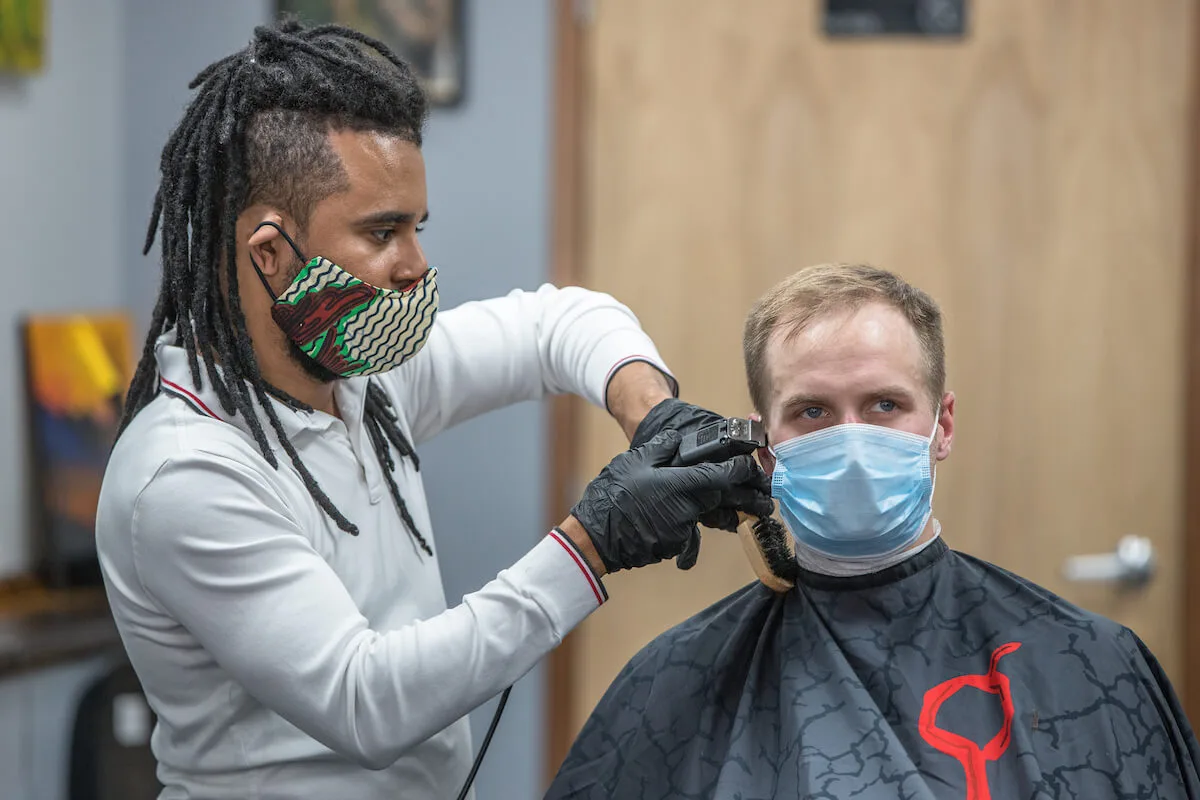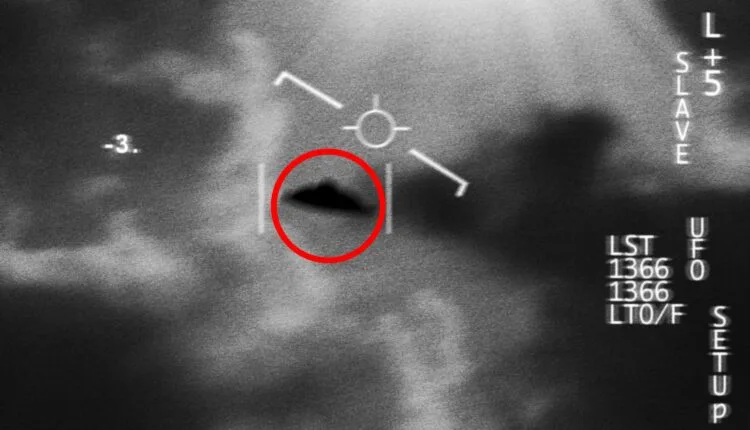
Kevin Rivera, barber at Midwood Barbers in Charlotte, cuts hair in late May while wearing a mask. Masks are required in personal care businesses like salons, but NC is considering a mandatory mask rule in all public spaces. (Photo for Cardinal & Pine by Grant Baldwin)
Researcher’s study delved into effectiveness of various face masks, found novel coronavirus too unpredictable to say when masks won’t be necessary.
One of the co-authors of a key Duke University study measuring the effectiveness of face masks says we should anticipate wearing masks for the foreseeable future regardless of the development of a vaccine.
“Guidelines for FDA approval of vaccines are only 50% effectiveness, Warren S. Warren, Director of the Center for Molecular and Biomolecular Imaging at Duke University, told Cardinal & Pine. “They will approve a vaccine if only half of people develop antibody response. How long that antibody response will last, nobody knows. How rapidly this is going to mutate? Nobody knows. And what the real short term and long term implications of getting this disease are, nobody knows.”
He added, “So you put all those things together, and it’s absolutely clear that masks are going to be with us for a long time if anybody really cares about other people.”
A study Warren co-authored was published this month in Science Advances, a peer-reviewed scientific journal.
N-95 Mask Got Top Marks, Gaiters Not So Much
Not surprisingly, it was the fitted N-95 mask that disbursed the lowest number of droplets. Three-layer surgical masks also performed extremely well, slightly better than homemade cotton masks.
And, although bandanas performed poorly, “gaiters” (a type of neck fleece often worn by runners) were by far the poorest performers. The gaiter that was used in the study was made of polyester and spandex. Droplet transmission from the gaiter actually exceeded maskless droplet transmission.
“We can’t emphasize enough that this is a limited study,” Warren told C&P. “This is not a large-scale clinical trial of thousands of different kinds of masks. This was about ‘What can we do, and what can do that we can do quickly?’ … What we did find that is significant is that almost all of the cotton masks of the common designs you see people wearing do a pretty decent job. They do about as well as the disposable surgical masks.”
RELATED: States that Didn’t Require Masks Saw COVID-19 Cases Surge

When discussing the surprising results associated with the gaiter, Warren hypothesized that large droplets were dispersed into a multitude of smaller droplets when filtered through the ubiquitous face coverings.
“Large droplets are getting broken up into small droplets. Those are more dangerous because the large droplets drop to the ground very quickly. The small droplets get disbursed a lot farther,” he said.
“Those people who are wearing masks are trying to do the right thing,” Warren added. “They just aren’t getting guidance of what the right thing is. I think if people realize they are trying to do the right thing but are actually wearing a mask that makes things worse, most people are likely to change.”
How the Study Came Together
The Duke study was conducted after Eric Westman, an associate professor of medicine at Duke University, reached out to Duke’s physics department for help. Westman was preparing to purchase a large number of masks on behalf of Cover Durham, a non-profit organization that distributes facemasks to underserved populations in the Durham area.
Westman was familiar with a National Institute of Health (NIH) study in which lasers were used to measure the amount of COVID-19 particles released by talking without a mask. The study concluded that these particles can remain in the air for 8 to 14 minutes. Westman asked colleagues in the physics department at Duke if they would be able to replicate the study using masks.
The timing of Westman’s request was problematic. It was April, and Duke University was at the height of its COVID-19 lockdown. Due to the importance of the study, Martin Fischer, an associate research professor in Duke’s chemistry department, was given permission to access his campus laboratory.
Social distancing protocols made it impossible for Fischer, director of Duke’s Advance Light Imaging and Spectroscopy Facility, to enlist help from other faculty members or students. As a result, he brought in a member of his own household—his daughter Emma–to assist him. Emma, a co-author of the study, is a junior majoring in neuroscience at Duke.
In order to conduct the study, Fischer constructed a simple black box. The box contained an opening at the front and had a cell phone camera mounted at the back. Participants spoke into the box with and without a mask. They tested it on 14 different face coverings.
As the phrase “Stay healthy, people” was repeated five times, a laser beam passed through slits in the box and lit up the respiratory droplets in the air. The droplets were recorded by cellphone video, and a computer algorithm was used to count them. This protocol was repeated 10 times for each facemask. The entire experimental setup was easy to build and cost less than $200.
On Resistance to Wearing Masks
When asked about the reluctance of many Americans to wear masks, Warren said he believes it stems in part from misinformation that was provided by public health officials at the beginning of the COVID-19 outbreak.
At that time, the virus was believed to have been primarily transmitted through contaminated surfaces and touching of the face. As a result, the U.S. Surgeon General, the US Centers for Disease Control and Prevention (CDC), and the World Health Organization said healthy people should not wear masks.
But in April, the CDC reversed course and recommended that all Americans wear masks.
It is now generally accepted within the scientific community that COVID-19 is primarily spread through respiratory droplets dispelled by an infected person. Evidence also indicates that non-symptomatic people can spread the virus. Mask-wearing mandates have become a political issue, and some Americans view mask mandates as an attack on their individual freedom. Given today’s contentious political climate, Warren said he does not find this surprising.
“I think that we live in an extremely political world,” he said. “Politics has unfortunately gotten meshed up with making good scientific decisions. The most obvious one is the use of HCQ—hydroxychloroquine. The science got put aside by the politics, and there are plenty of people on both sides that you can blame for that one. It’s understandable that people think that politics is playing a role because politics is playing a role in an awful lot of other things.”
Politics

Op-ed: Michele Morrow poses a huge threat to NC public schools
Students with disabilities would particularly suffer if Michele Morrow were to become the state Superintendent of Public Instruction, Susan Book...

Biden makes 4 million more workers eligible for overtime pay
The Biden administration announced a new rule Tuesday to expand overtime pay for around 4 million lower-paid salaried employees nationwide. The...
Local News

The 5 most believable UFO sightings ever reported in North Carolina
Read about five alien encounters that may forever remain unexplained. When you think of the most common places where you might hear a UFO sighting...

Good News Friday: It’s a good day to be a fan of the NC State Wolfpack
The men's and women's teams will compete for a national championship in college basketball this weekend. Plus: How to watch the solar eclipse, and...




